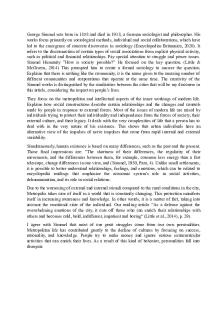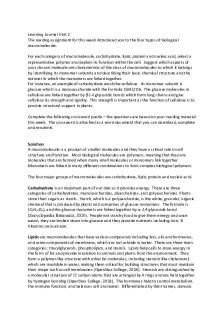Unit 2 biology journal assignment PDF

| Title | Unit 2 biology journal assignment |
|---|---|
| Course | Biology 1 for Health Studies Majors |
| Institution | University of the People |
| Pages | 3 |
| File Size | 106.9 KB |
| File Type | |
| Total Downloads | 12 |
| Total Views | 132 |
Summary
BIOLOGY 1121 UNIT 2 JOURNAL ASSIGNMENT ...
Description
U2 Learning Journal - Crossword
Z Y 2M O N M 3S E E R 6G 7L Y C E R I O P N 9F I D D 12A M I R Y O
1E N
E
4C E O L L R U C T O L N O A C I S E 14P H
5G L 8C A R B O X Y L C S E 10C O 11T R A N S 13D R I E B D O S P H O L I P I D15 X H C E Y Y H 17S A T U R A T E D Y I R D B A 18U R A C O
T
S
E
A T 19P
E
Across
Down
16R U R I L
E P
T
I D E O
20T W E
NT Y
1. protein that acts as a catalyst in biochemical reactions
2. single unit of a polymer
6. component of fat molecule
3. structure of polypeptide chain that contains beta sheets
8. acidic group in amino acids
4. provides structural support in plant cells
9. monosaccharide commonly found in fruit
5. type of bond between monosaccharides in a chain
11. fatty acid with hydrogens in different planes
7. used for long term energy storage
12. monomer subunit of protein
10. biological macromolecule with a ratio of 1 C:2 H:1 O
14. major constituent of plasma membrane
13. sugar backbone of DNA
17. fatty acid containing no double bonds
15. type of reaction used to form polymers
18. nucleic acid found only in RNA
16. adenine and guanine are this type of nucleotide
19. bond formed between two amino acids
N E
U2 Learning Journal - Crossword
20. number of amino acids
BIOL1121 Unit 2 Learning Journal
For this assignment, we were asked : For each category of macromolecule, carbohydrate, lipid, protein and nucleic acid, select a representative polymer and explain its function within the cell. Suggest which aspects of your chosen molecule are characteristic of the class of macromolecules to which it belongs by identifying its monomer subunits and describing their basic chemical structure and the manner in which the monomers are linked together.
Carbohydrate: Lactose is a disaccharide consisting of the monomers glucose and galactose which are joined by a glycosidic bond. The formula is C12O22H11. It provides the cell with ATP for energy.
Lipid: Unsaturated fats, such as oils are lipids. They consist of a hydrocarbon chain with a double bond. They help to lower blood cholesterol. Oleic acid C18H34O2 is an example.
Protein: Amino acids are the monomers that make up proteins. There are 20 amino acids, each with an amino group and a carboxyl-acid group, but with a different “r” group, they are joined by peptide bonds. One example necessary for humans is cysteine- C3H7NO2S -because it plays a major role in protein rigidity therefore aids in collagen production, giving the skin its well deserved elasticity.
U2 Learning Journal - Crossword
Nucleic Acid: An important nucleic acid is deoxyribonucleic acid. It is important to the cell as it carries the genetic information for protein reproduction. Nucleic acids are made of monomers called nucleotides. Each nucleotide is made up of three components: a nitrogenous base, a pentose sugar, and a phosphate group. Each nitrogenous base in a nucleotide is attached to a sugar molecule, which is attached to one or more phosphate groups. The pentose sugar in DNA is deoxyribose. DNA has a double helix structure.
References: OpenStaxCollege,Biology.OpenStaxCollege.30May2013....
Similar Free PDFs

Unit 2 socio journal assignment
- 2 Pages

Learning Journal Unit 2
- 2 Pages

Learning Journal Unit 2
- 2 Pages

Learning Journal Unit 2
- 2 Pages

Learning Journal Unit 2
- 2 Pages

Learning journal unit 2
- 2 Pages

Unit 2 - molecular biology
- 48 Pages

Unit 5 cell biology assignment
- 17 Pages

Learning Journal Unit 2-2204
- 1 Pages
Popular Institutions
- Tinajero National High School - Annex
- Politeknik Caltex Riau
- Yokohama City University
- SGT University
- University of Al-Qadisiyah
- Divine Word College of Vigan
- Techniek College Rotterdam
- Universidade de Santiago
- Universiti Teknologi MARA Cawangan Johor Kampus Pasir Gudang
- Poltekkes Kemenkes Yogyakarta
- Baguio City National High School
- Colegio san marcos
- preparatoria uno
- Centro de Bachillerato Tecnológico Industrial y de Servicios No. 107
- Dalian Maritime University
- Quang Trung Secondary School
- Colegio Tecnológico en Informática
- Corporación Regional de Educación Superior
- Grupo CEDVA
- Dar Al Uloom University
- Centro de Estudios Preuniversitarios de la Universidad Nacional de Ingeniería
- 上智大学
- Aakash International School, Nuna Majara
- San Felipe Neri Catholic School
- Kang Chiao International School - New Taipei City
- Misamis Occidental National High School
- Institución Educativa Escuela Normal Juan Ladrilleros
- Kolehiyo ng Pantukan
- Batanes State College
- Instituto Continental
- Sekolah Menengah Kejuruan Kesehatan Kaltara (Tarakan)
- Colegio de La Inmaculada Concepcion - Cebu






